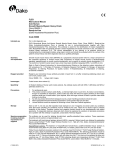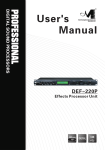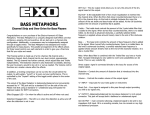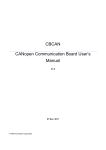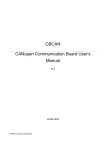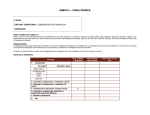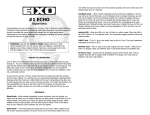Download Stereo Memory Man with Hazarai Instructions - Electro
Transcript
- QUICK START GUIDE - Basic Digital Delay/Echo Using TAP Tempo STEREO MEMORY MAN WITH HAZARAI Congratulations on your purchase of the Electro-Harmonix Stereo Memory Man with Hazarai. The Stereo Memory Man with Hazarai (SMMH) is a digital delay pedal with three different types of echoes and a full-fledged looper all of which work in true stereo. Special Features of the Stereo Memory Man with Hazarai: • • • • • • • • • • • • • Up to 3 seconds of delay time. Up to 30 seconds of loop time. Tap Tempo Footswitch allows you to set the delay time with your foot. Multi-Tap delay allows you to set the exact number of echo repeats. A full-featured looper gives you the ability to record a loop of exactly what you are hearing at anytime, set to any length up to 30 seconds. Record overdubs over your loop at anytime. Loop mode allows you to reverse the loop, change just the tempo or change both pitch and tempo. Reverse Echo is an intelligent reverse delay that monitors your picking to create optimal reverse delays of the notes you play. Multi-Tap plus Reverse allows you to use a straight echo and also have a Footswitch controlled reverse effect. Echo + Mod gives you delay modulation where the user controls the total amount of modulation. A Low Pass or High Pass filter is always available to process the delayed or looped signals. Save and load up to 8 presets: 1 preset for each different mode. Mono In to Stereo Out creates a ping-pong effect where the echoes bounce between the two outputs. 1. 2. 3. 4. 5. 6. 7. 8. 9. Connect the output plug from the AC Adapter to the 9V jack at the top of the Stereo Memory Man with Hazarai. Plug the AC Adapter into a wall outlet. Plug your instrument into the MONO/Left Input Jack. Plug your amp into the MONO/Left Output Jack. Press the BYPASS footswitch so the STATUS LED is on Turn the HAZARAI knob so that the top LED is lit: ECHO-3 SEC. Turn the following knobs to 50% or 12 o’clock: BLEND, FILTER and REPEATS. Turn the DECAY knob fully counter-clockwise. Tap in a delay time by pressing and releasing the TAP Footswitch at least two times. The time between the taps will be your delay time. To change delay time, either tap in a new time or turn the DELAY knob. Add Filtering To Your Basic Digital Delay/Echo 10. After setting your delay in the above Quick Start section, begin to turn the FILTER knob counter-clockwise to the 9 o’clock position, you will hear a reduction in the treble or high frequency content of your echoes. There will be less treble with each repeat. 11. Now turn the FILTER knob clockwise, passed the center point to the 3 o’clock position. The echoes will now go through a high pass filter so the bass or low frequency content of the echoes will be reduced. Add Reverb To Your BASIC Digital Delay/Echo 12. Return the FILTER knob to the 12 o’clock position. 13. Now turn the DECAY knob up to 3 o’clock. The repeats of you delay are smeared to produce a reverberant sound. 14. Now try turning the REPEATS and DELAY knobs down to their counter-clockwise positions, this will yield a more straight-forward reverb effect. WARNING: Use only the US96DC-200BI adapter that the Stereo Memory Man w/ Hazarai comes supplied with. Do not use any other AC adapters. Using other AC adapters, even those made by Electro-Harmonix, could cause harm to the unit, the adapter or you. The SMMH does not use batteries. 1 2 Multi Tap Delay/Echo w/ 3 Repeats while Using Tap Tempo 1. 2. 3. 4. 5. 6. Use the same connections as in the steps above. Turn the HAZARAI knob so that the MULTI TAP-1 SEC + REV LED is lit. Turn the following knobs to 12 o’clock: BLEND, DECAY and FILTER. Turn the REPEATS knob to 9 o’clock. This should yield approximately 3 repeats. TAP in a delay time by pressing and releasing the TAP Footswitch at least two times. The time between taps will be your delay time. To change delay time, either tap in a new time or turn the DELAY knob. Reverse Playback With TAP Footswitch and Multi Tap Delay/Echo 7. 8. Play a chord and allow it to ring out for a couple of seconds. Now press and hold down the TAP Footswitch, the chord will playback in reverse as long as you hold down the TAP Footswitch. Fade In Repeats With Multi Tap Delay/Echo 9. Turn the DECAY knob clockwise to its maximum setting. The repeats of the echo will get progressively louder. 10. This effect may be more effective with more repeats and a shorter delay time so turn the REPEATS knob to 3 o’clock and turn the DELAY knob to 10 o’clock. Fun With Reverse Delay/Echo 1. 2. 3. 4. 5. 6. Use the same connections as in the steps above. Turn the HAZARAI knob so that the REVERSE ECHO LED is lit. Turn the following knobs to 12 o’clock: BLEND, FILTER and DELAY. Turn the following knobs down to their counter-clockwise positions: DECAY and REPEATS. This setting should give you a nice reverse echo. Turn the DELAY time knob or tap in a new delay time to hear the Reverse Echo work with different delay times. Turn the REPEATS knob up to hear the echo fade away over a number of repeats. Adding Multiple Playbacks To The Reverse Echo 7. Turn the REPEATS knob down to its counter-clockwise position. 8. Turn the DECAY knob up to 10 o’clock. You should hear approximately 5 repeats. 9. The further clockwise you turn the DECAY knob the more repeats you will hear. The more repeats that occur, the closer together they will be. 3 Recording a Loop 1. 2. 3. 4. 5. 6. 7. 8. 9. Use the same connections as in the steps above. Turn the HAZARAI knob counter-clockwise so that no mode LEDs are lit. You are now in LOOP mode. Turn the following knobs to 12 o’clock: BLEND, DECAY, FILTER and DELAY. Turn the REPEATS knob to its maximum clockwise position. Simultaneously step on and hold the TAP/RECORD Footswitch while beginning to play the first notes of your loop. Continue to hold down the TAP/RECORD Footswitch while recording your loop. When you are ready to end the loop, release your foot from the TAP/RECORD Footswitch. At the moment you release the TAP/RECORD Footswitch, the loop will end and begin playing from the beginning. The LOOP LED will light up to indicate that there is a loop in memory. While the loop is playing, you can play along with the loop. Overdubbing On Top Of The Loop 10. You can record new audio on top of the loop you just recorded. 11. Step on and hold the TAP/RECORD Footswitch at any time when the loop is playing back. The SMMH will immediately begin overdubbing onto the loop. You must hold the TAP/RECORD Footswitch for at least half a second for the SMMH to register the overdub. 12. While you are holding down the TAP/RECORD Footswitch, the SMMH will record the new notes you play onto the loop. 13. When you are finished with your overdub, release the TAP/RECORD Footswitch. Reverse The Loop 14. Turn the DECAY knob to the extreme counter-clockwise position. The loop will change direction and playback in reverse. 15. To turn the loop back around to the forward direction, turn the DECAY knob all the way to the extreme clockwise position. Change The Loop’s Speed 16. Turn the DELAY knob clockwise; as you turn it you will hear both the pitch and tempo of the loop increase. The loop speed will increase up to double the original speed or one octave up. 17. Turn the DELAY knob counter-clockwise, as you turn it you will hear the speed of the loop decrease down to half the loop’s original speed or one octave down. 4 Play Along With The Loop Using Echo 18. While the loop is playing, turn the HAZARAI knob clockwise to your favorite echo mode. 19. Turn the knobs to create an echo effect that you like. 20. Start playing with your loop while echoes are applied to your notes. 21. You can overdub at this point if you like. Press and hold the TAP/RECORD Footswitch. The echoes will be recorded in the overdub. Erase The Loop 22. Press the BYPASS Footswitch so that you enter Bypass mode and the STATUS LED is off. 23. Press and hold the TAP/RECORD Footswitch for half a second. 24. Release the TAP/RECORD Footswitch once the LOOP LED goes off, the loop is now erased forever. Saving a PRESET 1. 2. 3. 4. - DESRIPTION OF MODES The Stereo Memory Man with Hazarai has 8 modes to choose from. Each mode gives the musician a different sonic palette to work with. In addition each mode changes the function of some of the SMMH’s knobs. In this section we will describe each mode and the functionality of the knobs that change with the mode. Use the HAZARAI knob to cycle through the modes. Turning the HAZARAI knob Clockwise goes up the LED ladder. Turning the HAZARAI knob Counter-Clockwise goes down the LED ladder. Below is a table displaying the function of each knob as it relates to the selected HAZARAI mode. Arrows indicate the function that occurs as the knob is turned to or towards the extreme knob position in that direction. You will notice some knobs, such as BLEND do not change with the HAZARAI mode while others, such as DECAY have a different function for nearly every different HAZARAI mode. When you create an echo effect that you like, you can save the sound as a preset. To save a preset, press and hold down the HAZARAI knob. You will need to hold down HAZARAI for 3 seconds. After holding down the HAZARAI knob for 2 seconds, all of the MODE LEDs will blink for 1 second. After they stop blinking, the preset is saved and you can release the HAZARAI knob. Upon releasing the HAZARAI knob, the PRESET LED will light up to indicate that a preset is currently loaded. Loading a Preset 5. Turn the HAZARAI knob to the mode LED where you saved the preset. 6. Press and release the HAZARAI knob. The PRESET LED will light. Your preset is now loaded. 7. The knob positions no longer represent the effect you hear. 5 6 ECHO Modes The Echo modes are basic delay/echo effects with some added features: 3 SEC ECHO Mode: The DELAY knob’s maximum time is 3 seconds. It is possible, in this mode, to obtain smeared reverberant echoes and to make the SMMH sound like a reverb. The DECAY knob adjusts between discrete echoes like a basic echo would have and smeared reverberant echoes. 1 SEC ECHO Mode: The DELAY knob’s maximum time is 1 second. In this mode, the DECAY knob will adjust between discrete echoes and diffused reverberant echoes. 300 mS + MOD ECHO Mode: The DELAY knob’s maximum time is 300mS. This mode gives the musician the ability to modulate the delay time. Set the depth of modulation by turning the DECAY knob clockwise. If you set the SMMH to have short delay times you can obtain Flanger and Chorus type sounds. With a long delay time you will actually hear each discrete echo change its pitch from your original note. Please note: when using modulation, use caution when the REPEATS knob is set above 3 o’clock. The SMMH may oscillate and blow speakers (or minds or both). KNOB FUNCTIONS: DECAY Knob: In 3 SEC and 1 SEC modes, the DECAY knob changes the echoes from discrete to diffused and reverberant. As you turn the knob clockwise they will be more reverberant. In 300 mS + MOD mode, the DECAY knob adjusts the depth or amount of delay modulation. Turn the DECAY knob clockwise to obtain more modulation. When set to its most CCW position the modulation will be off. REPEATS Knob: Acts like a feedback control as seen on vintage delays and echoes. As you turn the REPEATS knob clockwise, it will take longer for the echoes to fade away. DELAY Knob: Sets the Delay Time for the Echo. In 3 Sec mode the maximum delay time is 3 seconds. In 1 Sec mode, the maximum delay time is 1 second. In 300 mS + Mod, the maximum delay time is 300 mS. 7 MULTI TAP Echoes The Multi Tap echo modes allow a musician to set the exact number of delay repeats and the relative volume of each repeat for their echo. Instead of hearing the repeats fade away, you could set the SMMH so that it produces exactly 3 repeats and each repeat is at the same volume. The Multi Tap modes allow the musician to set the SMMH to repeat the echo a fixed number of times up to 30 repeats (as long as there is enough delay memory). In addition, the SMMH can be configured so that all repeats playback at the same volume, decrease in volume with each repeat or increase in volume with each repeat. 3 SEC MULTI TAP Mode: The DELAY knob’s maximum time is 3 seconds. 1 SEC MULTI TAP Mode: The DELAY knob’s maximum time is 1 second. 1 SEC + REV MULTI TAP Mode: The DELAY knob’s maximum time is 1 second. Of the 8 modes, this is the only one where holding the down the TAP footswitch does not record or overdub a loop. Instead, at the moment that one presses the TAP footswitch, a backwards version of the dry signal will start to play, starting with the most recent and continuing while the footswitch is held, up to a maximum of 6 seconds. This is useful when the musician wants control over exactly when to begin reverse playback. For example you could play and hold a chord, after a few seconds, hold down TAP and you will hear your chord play backwards. KNOB FUNCTIONS: DECAY Knob: Sets the relative volume for each repeat. Setting the DECAY knob to the center (12 o’clock) will make each Repeat playback at equal volume. Turning the DECAY knob counter-clockwise from the center will cause the repeats to decrease in volume with each successive repeat. When turned to the extreme counter-clockwise position you will only hear the first repeat. Turning the DECAY knob clockwise from the center will cause the repeats to increase in volume with each successive repeat. REPEATS Knob: Sets the number of repeats from 1 (CCW) to 30 (CW). DELAY Knob: Sets the Delay Time for the Multi Tap Echo. In 3 Sec mode the maximum delay time is 3 seconds. In the 1 Sec and 1 Sec + Rev modes the maximum delay time is 1 second. 8 DÉJÀ VU Modes: The Déjà Vu section contains Reverse Echo, the Looper and Presets. We will discuss each mode separately. REVERSE ECHO Mode The echoes will playback in reverse. The Reverse Echo in the SMMH is an intelligent reverse echo; it studies your playing so that it can produce reverse echoes that best suit your delay time setting. Please Note: to take full advantage of the intelligent reverse echo feature, we recommend the DECAY knob be turned all the way down to the counterclockwise position. KNOB FUNCTIONS: DELAY Knob: Sets the Delay Time from a minimum of 0.2 mS to a maximum of 3 seconds. DECAY Knob: Sets the number of replay voices from 1 to 25. As you turn the DECAY knob clockwise you will obtain more voices. The replay voices act a bit like having a reverse multi-tap echo. Multiple versions of the same echo will playback simultaneously. The more voices you have, the closer together the voices will be when played back. To hear only one voice, turn the DECAY knob down to its most counter-clockwise position. The intelligent Reverse Echo works best when DECAY is at its minimum setting and there is only one voice. REPEATS Knob: Acts like a feedback control. The further clockwise you turn the REPEATS knob, the more echoes you will hear and the longer it will take for the echoes to fade away. LOOP Mode You can record a loop anytime while using the SMMH, except while in the MULTI TAP-1 SEC + REV mode. When recording a loop while in the echo modes, the loop will be recorded from the output of the BLEND control so that what hear is what is recorded. In addition, after recording a loop in an echo mode, by switching to LOOP mode you can alter the loop by reversing the loop, filtering the loop or changing the speed or tempo of the loop. To record a dry loop without any echoes mixed in, select LOOP mode prior to recording the loop. To enter loop mode turn the HAZARAI knob counter-clockwise until either no LEDs are lit, or only the LOOP LED is lit. Please Note: If no mode LEDs are lit, it means you are in LOOP mode. LOOP RECORD PROCEDURE: 1. 2. 3. 4. 5. 6. To begin recording a loop, press and hold down the TAP/RECORD Footswitch. The SMMH will begin recording the loop the instant you press down on the TAP/RECORD Footswitch. Keep holding down the TAP/RECORD Footswitch for the duration of the loop recording. You must hold down the TAP/RECORD Footswitch for a minimum of half a second for the SMMH to register that a loop is being recorded. Once this time has elapsed, the LOOP LED will light up to indicate that there is a loop in memory. To end the recording of the loop, release the TAP/RECORD Footswitch. At the instant you release the TAP/RECORD Footswitch, the SMMH will end the loop recording and will immediately playback the loop from its beginning. The length of the loop is equal to the length of time you hold down the TAP/RECORD Footswitch. The loop will now play continuously unless you enter Bypass mode. You may play over the loop while in any of the 8 modes. While the loop is playing, the LOOP LED will blink once to indicate the loop has cycled back to the beginning. LOOP OVERDUB PROCEDURE: 1. 2. 9 Once you have a loop in memory, you may overdub onto the loop at anytime by pressing and holding the TAP/RECORD Footswitch. The SMMH will begin recording the overdub from the instant you press down on the TAP/RECORD Footswitch. The SMMH will record the overdub for the entire duration that you hold down the TAP/RECORD Footswitch. 10 3. 4. To end overdub recording, release the TAP/RECORD Footswitch. You must hold down the TAP/RECORD Footswitch for a minimum of half a second, if you hold it for less time it will register as a Tap, not as an Overdub. Overdubbing will not change the length of the loop. The loop’s length remains constant once it is recorded. LOOP ERASURE PROCEDURE: 1. 2. Press the BYPASS Footswitch to enter bypass mode: STATUS LED off. Hold down the TAP/RECORD Footswitch for half a second. The LOOP LED will turn off when the loop has been erased. Please Note: Loops will be erased when power is disconnected. The SMMH does not save loops after power cycling. KNOB FUNCTIONS: DELAY Knob: In Loop mode, the DELAY knob changes the speed of the loop continuously up or down one octave. By speed, we mean both the pitch and tempo of the loop will change. It is like changing the speed of a tape machine while it plays back a recording. Setting the DELAY knob to 12 o’clock plays the loop back at the original speed it was recorded. Turning the DELAY knob clockwise will increase the speed of the loop up to twice the speed or one octave. Turning the DELAY knob counter-clockwise will reduce the speed of the loop down to half the original speed or down one octave. The DELAY knob changes the loop’s speed in a continuous fashion. Please Note: when you record a new loop, the DELAY knob will default to its 12 o’clock position (no speed change), even if the knob is located at some other point. You have to move the knob in order hear a change in speed. REPEATS Knob: While in Loop mode, the REPEATS knob sets the attenuation level of the loop in memory while overdubbing onto the loop. If you set the REPEATS knob to the full clockwise position, no attenuation will occur and you will hear the old loop at the same volume level as before overdubbing. If you turn the REPEATS knob to full counter-clockwise, the previously recorded loop will be completely erased (though the length of the loop will not change). Set the REPEATS knob to 12 o’clock and you will a hear 50% volume drop in the previously recorded loop. Again this only occurs while overdubbing. FILTER Knob: This knob filters the loop much like it filters the echoes. When set to 12 o’clock there is no filtering. Turn the knob counter-clockwise and a low pass filter will be applied to the loop. The further you turn the knob counterclockwise the lower the frequency of the low pass filter. Turn the knob clockwise from the 12 o’clock position and the loop will go through a high pass filter. Again the further you turn the knob in the clockwise direction the higher the frequency of the high pass filter. 11 DECAY Knob: In Loop mode, the DECAY knob is used to Reverse the loop. Turn the DECAY knob to the full counter-clockwise position and the loop will reverse once you reach the stopping point of the DECAY knob. To flip the loop back around to the forward direction, turn the DECAY knob to the full clockwise position. Once the DECAY knob reaches the end of the rotation the loop will play forwards. Please Note: You must turn the DECAY knob full clockwise or counter-clockwise to reverse or forward the loop. The DECAY knob will always default to the forward position after recording a new loop. You must move the knob to reverse the loop. TAP/RECORD Footswitch: This footswitch has multiple functions in LOOP mode. RECORDING/OVERDUBBING: To record or overdub a loop, hold down the TAP footswitch for at least half a second. The loop will begin recording the instant you press down on the TAP footswitch but you need to keep it down the entire length of the loop. Releasing the TAP Footswitch will end the loop recording. The length of time the TAP Footswitch was held down will determine the loop’s length. To overdub, hold down the TAP footswitch for the entire length of time you wish to overdub onto the loop. When overdubbing you do not need to hold the Footswitch down for the entire loop length, just for the amount of time you want to overdub onto the loop. For the SMMH to register an overdub you must hold down the TAP Footswitch for at least half a second. TAPPING NEW TEMPO: After a loop has been recorded, it is possible to time expand and compress the loop without changing its pitch. Do this by tapping a new tempo with the TAP Footswitch. When tapping a new tempo, press and release the TAP Footswitch a minimum of two taps to change to the new tempo. Please Note: if you had changed the pitch of the loop using the DELAY knob, when you tap in the new tempo, the loop will immediately return to the original pitch of the loop. To change the pitch of the loop after tapping in a new tempo, turn the DELAY knob, then the pitch and tempo of loop will change simultaneously. 12 PRESETS The SMMH can save one preset for each of the 8 HAZARAI modes. Each saved preset will pertain directly to the mode you have saved it in. For example, if a preset is saved with exactly 7 repeats at a delay time of 300mS in the MULTI TAP-3 SEC mode, when you recall that preset it will sound exactly as it did when you saved it: 7 repeats at a delay time of 300mS. Once a preset is saved, the SMMH will remember the preset after power has been disconnected. When saving a preset to LOOP mode, it will save all of the knob settings but it will not save the loop. In addition, when loading a preset in LOOP mode, upon recording a new loop the DELAY and DECAY knobs will always change to their default settings even if you recalled a loop preset prior to recording the loop. Once the loop has been recorded, if you then recall the LOOP preset, it will restore both the DELAY and DECAY knobs to their stored values. This is the white knob located in the upper right corner of your SMMH. The HAZARAI knob is a rotary encoder enabling the user to scroll through the 8 Modes of the SMMH. Turn the knob clockwise to progress up through the modes: from LOOP to ECHO-3 SEC mode. Turn the knob counter-clockwise to progress down through the modes: from ECHO-3 SEC to LOOP mode. Saving a preset will save the setting of all 5 of the black knobs. It will also save a tapped in delay time if that is the current delay time at the moment of saving the preset. Please Note: when you are in LOOP mode the LOOP LED will only light if you have a loop in memory. If no modes are lit, that means you are in LOOP mode. PRESET SAVE PROCEDURE: The HAZARAI knob also has a push switch to save and load presets. To load a preset, turn the HAZARAI knob to select the desired mode and then give the HAZARAI knob a quick tap. Push it down then release it. To save a preset, push down and hold the HAZARAI knob for 3 seconds. You will then see all of the mode LEDs blink rapidly. Continue to hold down the HAZARAI knob until the LEDs stop blinking. At this point the preset is saved and you can let go of the knob. Only one preset is saved per mode and the preset you save is based on the current mode. 1. 2. 3. 4. To Save the sound you are currently hearing, press and hold down the HAZARAI knob. You will need to hold down the HAZARAI for 3 seconds. Nothing will occur for 2 seconds, then all of the mode LEDs will blink for 1 second. After the LEDs stop blinking, let go of the HAZARAI knob. The Preset LED will light up solid. Your preset has been saved in the mode that is currently lit. PRESET LOAD PROCEDURE: 1. 2. To Load a preset you previously saved: turn the HAZARAI knob to the mode where the preset was saved. Press and release the HAZARAI knob. The PRESET LED will light up to indicate that the Preset has loaded. Please Note: The current knob positions are no longer valid. After loading a preset, if you move a knob, the knob’s new location will supersede the preset’s stored value for that knob. At this point, the PRESET LED will blink rapidly to indicate that a knob has been moved. After loading a preset, turning the HAZARAI knob to another mode will cancel the last preset that was loaded and restore all of the current knob positions. - CONTROLS, INDICATORS & I/OThe following descriptions detail all of the knobs, switches, LEDs (lights) and I/O jacks on the SMMH: HAZARAI KNOB DELAY KNOB In all modes except LOOP mode the DELAY knob sets the Delay time for the echo. The total range of the DELAY knob varies depending on the selected mode. The following table displays the DELAY knob time range for each echo mode: MODE TIME RANGE ECHO-3 SEC ECHO-1 SEC ECHO-300mS + MOD MULTI TAP-3 SEC MULTI TAP-1 SEC MULTI TAP-1 SEC + REV DÉJÀ VU-REVERSE ECHO 1.8mS to 3150mS 0.6mS to 1050mS 0.2mS to 350mS 1.8mS to 3150mS 0.6mS to 1050mS 0.6mS to 1050mS 0.2mS to 3150mS Please Note: the delay time can also be set by the TAP/RECORD footswitch. The control that takes precedence is the one that is last touched. If you tap in a delay time, then turn 13 14 the DELAY knob, the tap time will be erased and the new delay time will be determined by where the DELAY knob is set. In LOOP Mode, the DELAY knob turns into a Loop pitch/speed control. Set the DELAY knob to 50% or 12 o’clock, the loop will playback as it was recorded. Turn the DELAY knob up from the center and the pitch and speed of the loop will increase up to twice the original loop’s speed. Turn the DELAY knob down from the center and the pitch and speed of the loop will decrease to half the original speed. The loop pitch/speed changes continuously without steps so that you can achieve pitches between the notes. Please Note: the DELAY knob will default to the center position when recording a new loop in LOOP mode even if the DELAY knob is physically set to a different setting. The right-hand or clockwise side of the knob controls the amount of High Pass filtering. The more you turn the Filter knob up to its maximum clockwise position, the higher the cutoff frequency of the high pass filter. This means less low frequency response; a reduction in bass. When the SMMH is set to LOOP mode, the filter knob will filter the loop just as it filters the echoes. Please Note: the Filter knob will default to the center position when recording a new loop in LOOP mode even if the Filter knob is physically at a different setting. DECAY KNOB The function of the DECAY knob changes depending on the mode selected. The following table describes the exact function of the DECAY knob for each mode: REPEATS KNOB The REPEATS knob is very much like the feedback control that is seen on many other types of delay units. The function of this knob changes depending on the selected mode. The following table describes the exact function of the REPEATS knob for each mode: MODE DECAY KNOB Function ECHO-3 SEC Varies between discrete echoes (0%) and smeared reverberant ones. Varies between discrete echoes (0%) and smeared reverberant ones. Controls the depth of the delay time modulation. 0% = no modulation. Controls the relative volume of each repeat. At 0% the first repeat will be loudest and the rest of the repeats inaudible. At 50%, all repeats will be at equal volume. At 100% the first repeat will be quietest and the last repeat will be the loudest. Sets the number of replay voices from 1 (0%) to 25. This is a bit like having a multi tap reverse echo. Please Note: the intelligent reverse echo feature works best when the DECAY knob is turned all the way down to the counter-clockwise position. Switches the loop direction from Forward to Reverse. Turn the DECAY knob to its minimum position (0%) to Reverse the loop. Turn the DECAY knob to its maximum position (100%) to switch back to Forward. After recording a new loop the DECAY knob will default to playing the loop forwards. MODE REPEATS KNOB Function ECHO-1 SEC ECHO Modes Controls the amount of delay feedback, from 0% to 99.99%. Sets the exact number of repeats from 1 to 30. Controls the amount of delay feedback, from 0% to 99.99%. When overdubbing, controls the volume attenuation of the previously recorded loop. Set to 0%, the previous loop will be erased. Set to 100% the previous loop will remain at the same volume. ECHO-300 mS + MOD MULTI TAP Modes REVERSE ECHO LOOP MULTI TAP Modes REVERSE ECHO FILTER KNOB The FILTER knob controls both a Low Pass or High Pass Filter on the delayed signal. When the knob is set to 50% or 12 o’clock, the frequency response is flat, there will be no filtering. The left-hand or counter-clockwise side of the knob controls the amount of Low Pass filtering. The further you turn the Filter knob down to its minimum counter-clockwise position, the lower the cutoff frequency of the low pass filter. This means less high frequency response; a large reduction in treble. 15 LOOP 16 BLEND KNOB seconds, then hold down the TAP/RECORD footswitch, you will hear your note played back in reverse. This gives you the ability to access Reverse playback that you can control directly with your foot. There is no loop recording while in this mode though if a loop is in memory it will continue to playback. The BLEND knob is a wet/dry control for the effect outputs. Turning the BLEND knob to its minimum counter-clockwise position will yield 100% dry and no wet signal. Turning the BLEND knob to its maximum clockwise position will give you 100% wet and no dry signal. To obtain a nice balance of both wet and dry signals turn the BLEND knob to 50%. TAP / RECORD Footswitch The TAP/RECORD footswitch has multiple functions assigned to it depending on the currently selected mode and how long the switch is pressed for. TAP Tempo Function: For all modes except LOOP mode: pressing the TAP/RECORD footswitch briefly two or more times sets the delay time. If the TAP/RECORD footswitch is pressed more than two times, the SMMH will average out the time between taps for the delay time. Loop RECORD Function: For all modes except 1 SEC + REV mode: pressing and holding the TAP/ RECORD footswitch for more than half a second will begin the recording of a loop. The loop will actually begin recording as soon as you press the footswitch but you need to keep the switch down for half a second so that the SMMH will know you are creating a loop. To end the loop recording release the TAP/RECORD footswitch. The loop length will be the total time that the footswitch was held down. Loop OVERDUB Function: For all modes except 1 Sec + Rev mode: while a loop is already playing, pressing and holding the TAP/RECORD footswitch for more than half a second will begin overdubbing onto the loop in memory. The SMMH will begin recording the overdub as soon as you press and hold the footswitch but it must be held for half a second for it to register as an overdub. The TAP/RECORD footswitch may be held for as long as needed for the overdub. This will not cause the loop length to change. REVERSE Play Function: In the 1 SEC + REV mode, pressing and holding the TAP/RECORD footswitch will begin reverse playback of the previous 6 seconds of dry playing. For example, when in this mode, if you play a note and let it fade out for a couple of 17 Loop TAP TEMPO Function: In LOOP mode, after you have recorded a loop, the SMMH will estimate the loop’s tempo based on the length of the loop. The Beat LED will blink at this estimated tempo. Briefly pressing the TAP/RECORD footswitch more than once will change the loop’s tempo without changing its pitch. Since you can also change the pitch and tempo of the loop using the DELAY knob the function last used will take precedence. Erasing a Loop: While the SMMH is in Bypass mode, the loop currently in memory can be erased by pressing and holding the TAP/RECORD footswitch for half a second. Once the loop has been erased the LOOP LED will turn off. BEAT LED In all modes except LOOP mode, the BEAT LED blinks at the same rate as the current delay time setting. If the delay time is below 50 mS the BEAT LED will blink so fast it will look like the LED is lit solid, this is normal. In LOOP mode the BEAT LED will blink on the beat of the loop’s tempo. BYPASS Footswitch / STATUS LED The Bypass footswitch toggles the SMMH between effect mode and bypass mode. If the STATUS LED is lit then the SMMH is in effect mode. If the STATUS LED is off, then the SMMH is in bypass mode. In Bypass mode, the MONO/Left Input Jack is connected directly to the MONO/Left Output Jack. The Right Input Jack is connected directly to the Right Output Jack. If no plug is inserted into the Right Input Jack, then the MONO/Left Input Jack will also connect to the Right Output Jack. 18 MONO/L and R INPUT Jacks The SMMH allows for full stereo input. The input jacks are labeled: Mono / L and R. When using the SMMH with only one input we suggest you use the MONO/L input. The input impedance presented at each input jack is 2 MΩ. MONO/L and R OUTPUT Jacks The SMMH has true stereo output. The output jacks are labeled: MONO/L and R. If using the SMMH as a mono effect we suggest you use the MONO/L input and output. The SMMH can also be used with Mono in and Stereo out. Plug your input into the MONO/L jack and then connect the MONO/L and R Outputs to two separate amps or inputs on a mixing board. When you connect the SMMH in a Mono to Stereo configuration, the delays will bounce or ping-pong between the two outputs. The first repeat will go out the MONO/L Output, the second repeat will go out the R Output, the third repeat out the MONO/L Output and so on. When you connect a plug to the R Input, the SMMH will stop the ping-pong effect: whatever goes into the Right Input will go out the Right Output, whatever goes in the Left Input will go out the Left Output. 9V Power Jack Plug the output of the SMMH’s supplied AC Adapter into the 9V power jack located at the top of the SMMH. The SMMH requires 9 - 9.6VDC at 200mA with a center negative plug. The SMMH accepts Boss style AC Adapters. Technical Specifications Sample Rate = 46.88 kHz A/D and D/A Conversion Bit Resolution = 24 bits Delay Audio Bit Resolution = 32 bits Looper Audio Bit Resolution = 32 Bits 19 20










